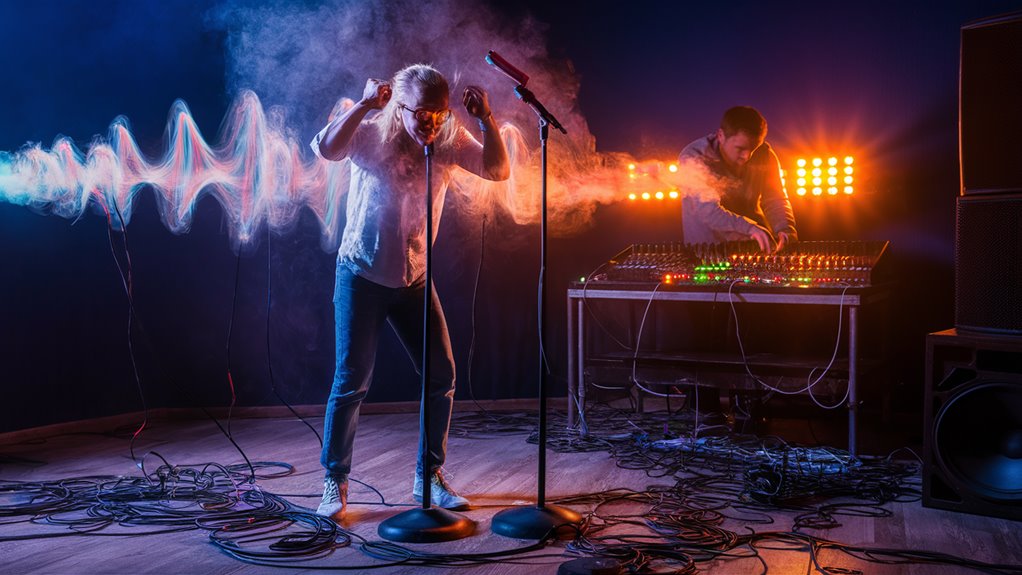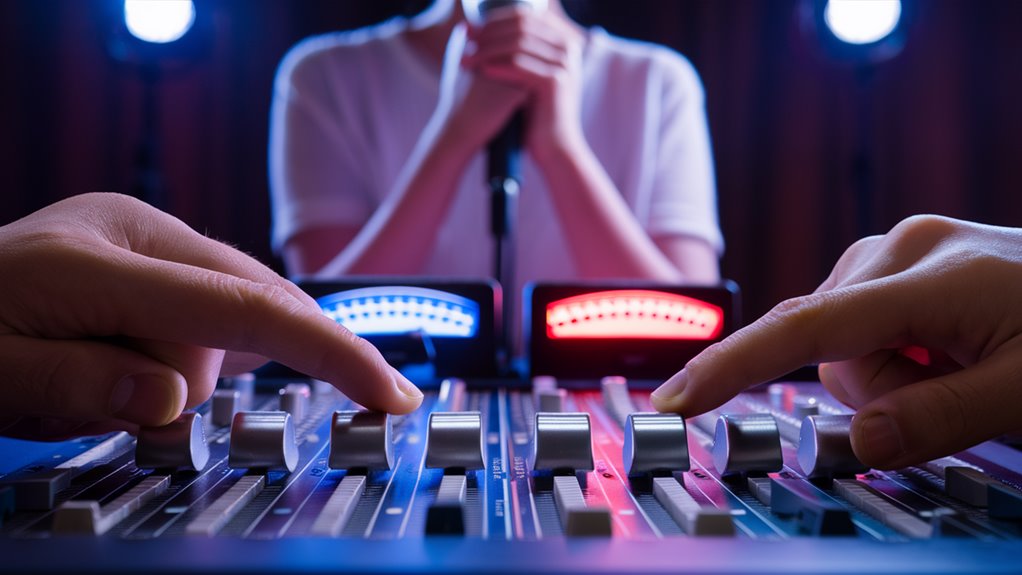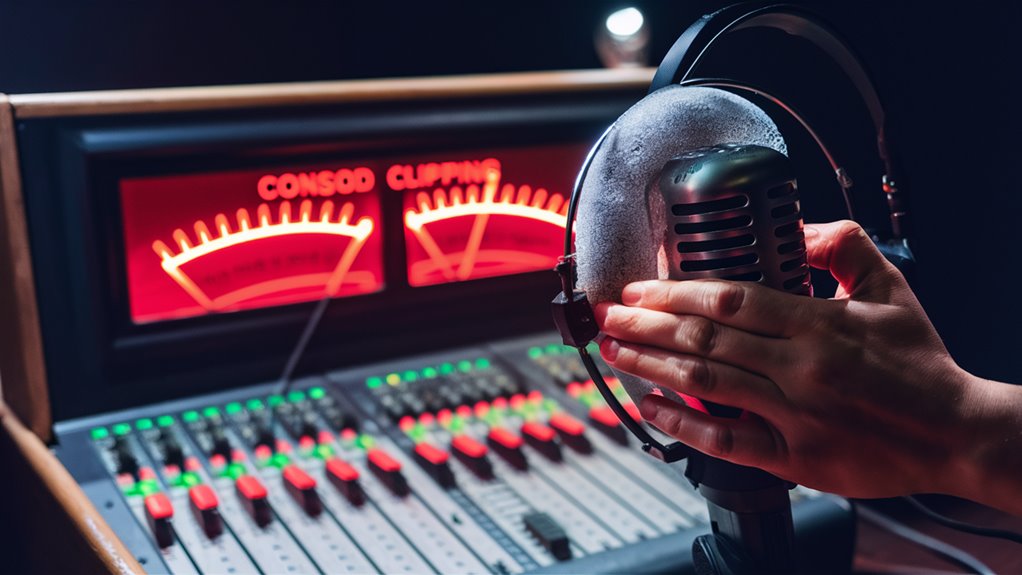
Fixing Karaoke Sound: How to Fix Usual Problems

Top Tips for Karaoke Sound Setup
To get good karaoke sound, you need to know tech and sound stuff well. Where the mic goes matters a lot to stop bad noise and keep songs clear. Set mics at a 45-degree angle and keep them at least 3 feet away from speakers. Also, use notch filtering in the 250Hz-4kHz area.
Making the Room Sound Better
Stopping echoes is key for karaoke. Placing absorption panels where sound hits back cuts down echoes. Keep the echo time (RT60) between 0.8-1.2 seconds for good sound mix. This setup keeps the sound clear but still warm.
Balancing Singing and Music
Handling sound signals right is the core of good karaoke sound. Set voice levels 6-8dB above the music for a good mix. Add a parametric equalizer tweak in the 200-400Hz zone to make the voice shine. Use high-grade digital sound handling for even sound every time.
Choosing the Right Sound System
Mix in a digital sound system and focus on good signal flow. Use top compression ways to keep the sound levels even and keep the rich sound. This smart way of doing sound leads to top-level results at all sound levels.
Keeping the Mic Clear of Feedback
Guide to Handling Mic Feedback
Basics of Stopping Feedback
Smart mic placement is your first fix against bad feedback. Set mics at least 3 feet from speakers and tilt them 45 degrees from main sound spots for the best sound setup.
Tweaking Settings for Best Results
Making Equalizer Changes
Manage tones with exact EQ to focus on the trouble 250Hz to 4kHz area where feedback often begins. Use notch filtering for a cleaner voice sound and set gain 6dB under the feedback chance point for steady sound.
Using Smart Systems
Set up automatic feedback control that finds and fixes issues in real time. Look for early feedback signs like ringing and cut the main volume by 3dB at the first hint of trouble. Angle floor monitors at 60 degrees to singers for the best mix of low feedback chance and good sound.
Right Monitor Setup
Where you place monitors is key for feedback control. Set floor monitors to send sound right to singers without hitting walls. Keep the right distance between sound parts to stop feedback loops and keep stable sound.
Handling Room Sound and Reflections
Handling Room Sound and Reflections Guide
Basics of Sound Reflection
Handling echoes and room sound is key for pro-level audio. Parallel walls and hard surfaces can cause strong waves and quick echoes, messing up your sound. Putting acoustic panels at key reflection spots, mainly at ear level, is needed for sound control.
Dealing with Ceiling Height and Sound
How high the ceiling is affects how sound moves around. High-ceiling spots need bass traps in corners to manage low tone build-up. Lower ceilings work better with sound diffusers that break up sound waves and cut down on unwanted echoes. The shape of the room changes how you manage sound, with different needs for rectangle spaces versus L-shaped or odd-shaped rooms.
Getting Echo Time Right
Measuring and fixing echo time (RT60) is a must for great sound. Mixing absorbing materials with shiny surfaces gets you the best RT60 zone of 0.8-1.2 seconds for voices. This balance keeps voice clear while keeping enough room sound for a rich sound place.
Setting Audio Input Right
Setting Audio Input Right for Pro Sound

Basics of Gain Staging
Right gain setting is key for the best sound in any system. Aim for input signals between -18dB and -6dB on mixer meters for needed space and sound clearness. This range makes sure of clean boosting without noise or breaking sound.
Calibrating the Mic
Start setting the mic input level with a steady test sound or long note. Tune the preamp gain so peak levels reach about -12dB on the meters. Set the channel EQ flat at first, then slowly lift the fader to the middle (0dB). Too much input gain can cause feedback loops and sound breaking.
Handling Backing Tracks and Mix
Standardize audio at -14 LUFS to lay a pro base for backing tracks. Keep vocal levels 2-3dB above the music for a clean, balanced sound that avoids common issues like signal cutting and weak boosting.
Important Tech Details:
- Right input range: -18dB to -6dB
- Peak mic levels: -12dB
- Backing track standard: -14 LUFS
- Vocal-over-music level: +2-3dB
Setting Speakers Right
Setting Speakers Right: The Complete Guide
Best Spots for Speakers for Perfect Sound
Pro speaker placement is a must for the best sound in karaoke places. Set main speakers at exactly 45-degree angles from the singing area, up 6-8 feet from the ground. This smart setup ensures perfect sound wave spread while cutting feedback.
Better Room Coverage
For big rooms over 500 square feet, delayed speakers are needed. Figure the right delay time using the 1-millisecond-for-each-foot rule from main speakers. Set up several speaker zones to keep sound level (SPL) even around the room within ±3dB.
Smarter Acoustic Fixes
Removing dead spots needs a deep look at room acoustics and smart extra speaker placement. In places with high ceilings (12+ feet), tilt speakers 10-15 degrees down to focus sound patterns on the crowd. Fixing parallel walls with acoustic panels helps stop strong waves, stops frequency cutting, and lifts voice clarity.
Voice and Music Together
Mastering Voice and Music Mix in Karaoke
Sound Mixing Basics for Pros
Perfect voice-to-music mix sets the standard for top karaoke sound mixing. Start with the vocal track 6-8 dB above the music for crystal clear singing while keeping the music backing. Use a parametric EQ between 200-400 Hz in the music track to make room for the main voice sounds.
Better Dynamics
Multiband compression on the vocal track keeps sound levels steady while keeping it natural. Pro settings use a -18 dB cut with a light 2:1 compression. Feedback control mixes narrow-band cuts with a 100 Hz low-pass filter, maximizing voice clarity and cutting out bad frequencies.
Precise Frequency Handling
Watching frequencies in real time helps you see where voice and music clash. Sharp EQ tweaks fix specific frequency issues without changing too much. Keep the music track top frequency at 16 kHz while letting vocals go full range for the best depth and feel in the mix 베트남 밤문화
Important Sound Details
- Vocal/Music Mix: +6-8 dB boost for voice
- EQ Zone: Make room at 200-400 Hz for singing
- Compression Setup: -18 dB cut, 2:1 compression
- Low-Pass Filter: Cut off at 100 Hz
- Music Top Frequency: Cap at 16 kHz
Advanced Digital Sound Handling
Digital Sound Handling in Sound Boosting
Basics of Digital Sound Handling (DSP)
Digital sound handling (DSP) turns simple sound into top-quality output with smart tech and real-time fixes. DSP tech lifts audio quality through smart digital changes, less noise, and better voice handling. The tech works in the digital area to give studio-level sound through math-based fixes.
Key DSP Jobs and Skills
Modern DSP machines do many big jobs at once for the best sound. Smart echo stopping cuts unwanted feedback between sound input and output gear, while dynamic EQ automatically tunes tone responses to fit different voices. Fast digital filters clear out sound glitches while keeping the real voice sound.
Better Digital Sound Fixes
Important DSP settings cover sample rate changes, bit depth fixes, and smart buffer handling. Digital compression stops sound mess-ups while keeping enough space for good sound levels. Anti-aliasing filters are key in stopping bad frequency glitches, ensuring clean sound output. With exact setting of these digital tools, DSP tech brings sound that fits top recording spots.
Main DSP Traits:
- Real-time sound fixes
- Smart noise cutting
- Classic favorites
- Precise frequency handling
- Dynamic range tuning
- Fast processing